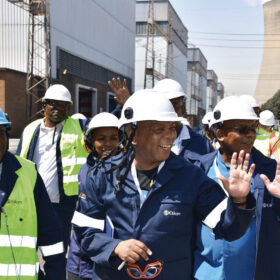South Africa targeting up to 5 GW of new renewables per year
The South African Renewable Energy Master Plan (SAREM) aims to deploy at least 3 GW of new renewables per year, increasing to 5 GW by 2030, while creating 25,000 jobs in the country’s renewable energy and storage sectors.
Load shedding returns to South Africa
The South African Photovoltaic Industry Association (SAPVIA) says that despite the return of load shedding over the weekend, the nation is still on track to permanently eliminate power outages.
South Africa adds 1.1 GW of solar in 2024
The South African Photovoltaic Industry Association predicts that deployment will accelerate as a strong pipeline of private and public utility-scale projects offsets the decline in installations from 2023 levels.
South Africa deploys 961 MW of solar in January-October period
The South African Photovoltaic Industry Association (SAPVIA) has shared forecasts with pv magazine projecting strong growth for the nation’s solar sector, despite a decline in deployment compared to last year. Utility-scale public sector plants are scheduled to come online next year for the first time since 2019.
South Africa imposes 10% import tariff on solar panels
The International Trade Administration Commission of South Africa (ITAC) has imposed a 10% import tariff on solar panels to protect local manufacturers, attract investment, and deepen the value chain. The South African Photovoltaic Industry Association has questioned the lack of formal industry engagement, calling the timing “not ideal.”
Weekend Read: Chaotic leadership leaves South Africans in the dark
Extensive load-shedding, lack of grid capacity, failing coal-fired power stations, lack of progress in clean power procurement, and even vandalism have prompted various South African government departments to take renewables generation into their own hands, seemingly without any overarching plan, as Bryan Groenendaal reports.
South Africa plans to allocate at least 6 GW of large scale solar by 2030
That would take the country to 8.28 GW of generation capacity by the end of the next decade with the government stating up to 6 GW of small scale capacity could be required on top. By that stage, however, coal would still amount to 43% of generation capacity and gas and diesel a combined 8.1%, under the new Integrated Resource Plan.
A specter is haunting South Africa, renegotiation of PPAs signed between 2011 and 2012
As national utility Eskom faces a financial and operational crisis, rumors are spreading that the government may ask independent power producers to renegotiate the tariffs of PPAs awarded in the first two rounds of its renewable energy program. South African solar association SAPVIA has already given short shrift to the idea.
South Africa to launch new 1.8 GW REIPPP round this year
After signing the 27 outstanding renewable PPAs assigned in previous rounds in April, the South African government believes the new procurement round may raise investment of more than $3.1 billion.
South Africa: Calls for 1.5 GW of annual PV, 55,000 new jobs – comment
The South African Photovoltaic Industry Association (SAPVIA) has called on the country’s government for more PV support. Energy specialist, Chris Ahlfeldt comments on the five point PV plan, which envisages 1.5 GW of new installs annually, and the creation of 55,000 jobs. He also discusses the ongoing issue of the 27 unsigned PPAs, and the bottlenecks in the market.








